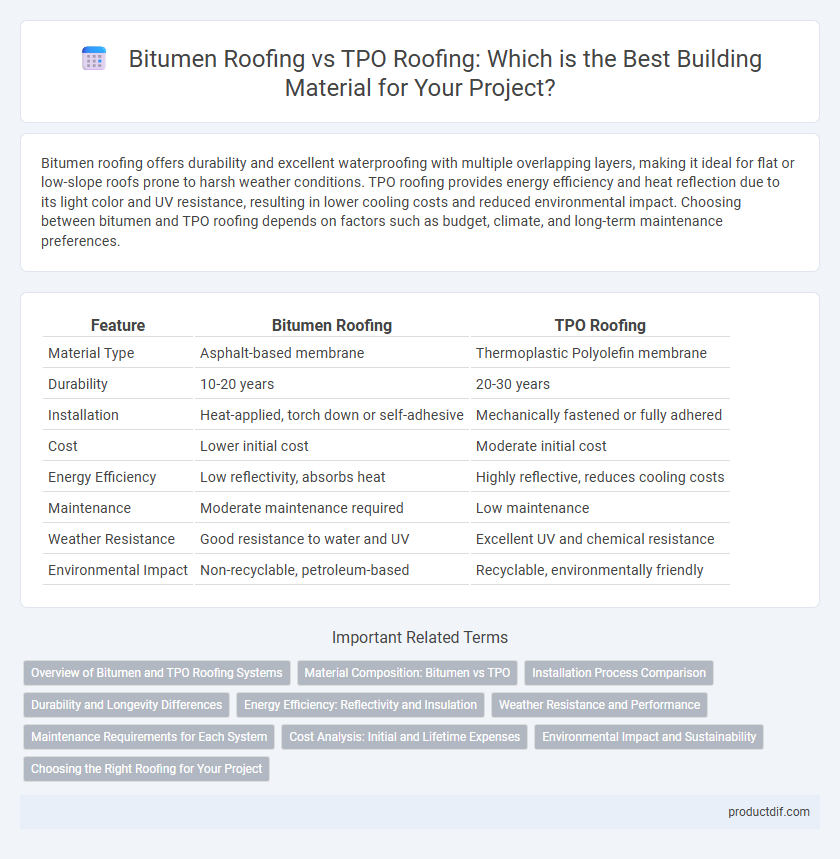Bitumen roofing offers durability and excellent waterproofing with multiple overlapping layers, making it ideal for flat or low-slope roofs prone to harsh weather conditions. TPO roofing provides energy efficiency and heat reflection due to its light color and UV resistance, resulting in lower cooling costs and reduced environmental impact. Choosing between bitumen and TPO roofing depends on factors such as budget, climate, and long-term maintenance preferences.
Table of Comparison
| Feature | Bitumen Roofing | TPO Roofing |
|---|---|---|
| Material Type | Asphalt-based membrane | Thermoplastic Polyolefin membrane |
| Durability | 10-20 years | 20-30 years |
| Installation | Heat-applied, torch down or self-adhesive | Mechanically fastened or fully adhered |
| Cost | Lower initial cost | Moderate initial cost |
| Energy Efficiency | Low reflectivity, absorbs heat | Highly reflective, reduces cooling costs |
| Maintenance | Moderate maintenance required | Low maintenance |
| Weather Resistance | Good resistance to water and UV | Excellent UV and chemical resistance |
| Environmental Impact | Non-recyclable, petroleum-based | Recyclable, environmentally friendly |
Overview of Bitumen and TPO Roofing Systems
Bitumen roofing systems consist of asphalt-based materials known for durability, waterproofing, and resistance to extreme weather conditions, commonly used in low-slope roof applications. TPO (Thermoplastic Olefin) roofing systems are single-ply membranes made from a blend of polypropylene and ethylene-propylene rubber, valued for energy efficiency, UV resistance, and ease of installation. Both roofing types offer distinct advantages in longevity, maintenance, and cost-effectiveness, with bitumen excelling in heavy-duty resilience and TPO favored for modern, reflective roofing solutions.
Material Composition: Bitumen vs TPO
Bitumen roofing is composed of asphalt-based materials, providing excellent waterproofing and durability through layers of reinforced fabric saturated with bitumen. TPO roofing consists of a single-ply membrane made from thermoplastic polyolefin, known for its UV resistance, heat-welded seams, and energy efficiency. The distinct material compositions influence performance characteristics, with bitumen offering robust waterproofing and TPO delivering flexibility and reflective properties.
Installation Process Comparison
Bitumen roofing installation involves layering sheets that are heat-applied or self-adhering, requiring skilled labor to ensure proper sealing and waterproofing. TPO roofing uses mechanically fastened, fully adhered, or ballasted methods with large sheets welded together using hot air, resulting in faster installation and reduced labor costs. Both systems demand precision, but TPO's single-ply membrane often expedites the process compared to the multi-layer bitumen approach.
Durability and Longevity Differences
Bitumen roofing offers excellent durability with its multi-layered asphalt construction, providing superior resistance to extreme weather and UV exposure, often lasting 15-20 years with proper maintenance. TPO roofing boasts high elasticity and heat-reflective properties, contributing to longevity of 20-30 years while resisting punctures, tears, and chemical exposure. Choosing between bitumen and TPO depends on project-specific requirements for durability, maintenance, and lifespan expectations.
Energy Efficiency: Reflectivity and Insulation
TPO roofing offers superior energy efficiency due to its high reflectivity, which reduces heat absorption and lowers cooling costs in buildings. Bitumen roofing, while durable, typically has lower reflectivity and relies more on insulation materials to achieve energy savings. Choosing TPO roofing can enhance energy performance by reflecting solar radiation and maintaining stable indoor temperatures.
Weather Resistance and Performance
Bitumen roofing offers excellent waterproofing and durability against extreme weather conditions, making it highly resistant to heavy rain and UV exposure. TPO roofing provides superior heat-reflective properties and flexibility, enhancing performance in high-temperature environments while maintaining resistance to UV rays, ozone, and chemical exposure. Both materials excel in weather resistance, but TPO systems generally offer longer lifespan and energy efficiency in hot climates.
Maintenance Requirements for Each System
Bitumen roofing requires regular inspections to identify cracks or blisters and often needs reapplication of protective coatings to maintain waterproofing. TPO roofing demands less frequent maintenance due to its UV resistance and heat-reflective properties, but seams should be checked periodically to ensure adhesion. Both systems benefit from routine cleaning to prevent debris buildup and prolong lifespan.
Cost Analysis: Initial and Lifetime Expenses
Bitumen roofing typically involves lower initial costs due to inexpensive materials and straightforward installation, but may require more frequent repairs and shorter lifespan, increasing lifetime expenses. TPO roofing has higher upfront costs driven by advanced membrane technology and energy efficiency features, yet offers longer durability and reduced maintenance costs, resulting in lower total ownership expenses over time. Careful cost analysis between initial investment and long-term savings is essential when choosing between bitumen and TPO roofing systems.
Environmental Impact and Sustainability
Bitumen roofing produces more greenhouse gas emissions during manufacturing and has limited recyclability, contributing to increased environmental burden. TPO roofing features a reflective surface that reduces energy consumption by lowering cooling costs and is often made from recyclable materials, enhancing sustainability. Choosing TPO roofing significantly supports eco-friendly construction practices and minimizes long-term environmental impact compared to traditional bitumen roofing.
Choosing the Right Roofing for Your Project
Bitumen roofing offers excellent waterproofing and durability, making it ideal for low-slope roofs with heavy foot traffic or complex details. TPO roofing provides energy efficiency and UV resistance, suitable for projects requiring reflective surfaces and environmental sustainability. Assessing roof slope, climate conditions, budget, and project lifespan helps determine whether bitumen or TPO roofing best fits your building's performance and maintenance needs.
Bitumen Roofing vs TPO Roofing Infographic

 productdif.com
productdif.com